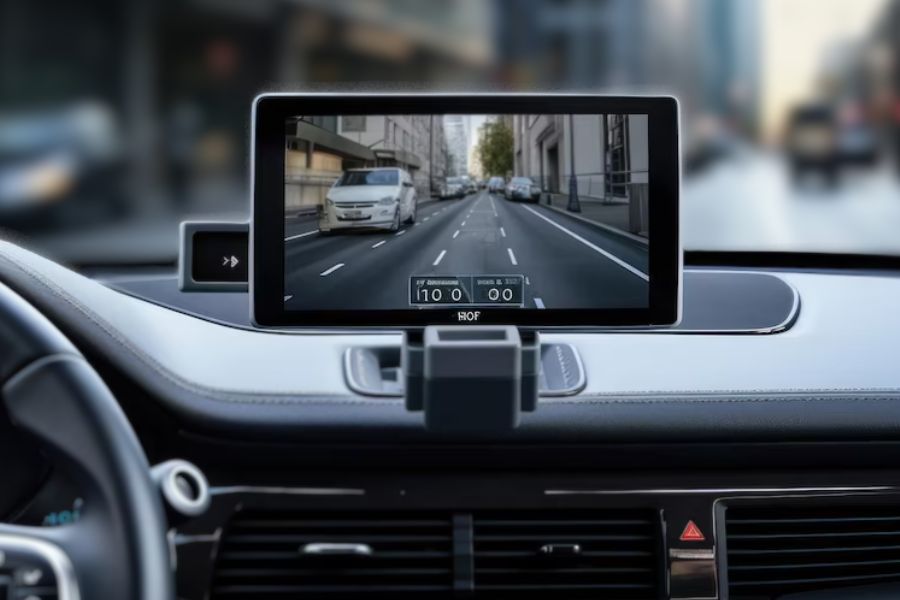In today’s fast-paced world, safety on the road has become paramount. Accidents and collisions have become all too common with the increasing number of vehicles on the road. That’s where rearview cameras come into the picture. These nifty devices have quickly become an essential feature in modern vehicles, providing drivers with extra eyes at the back of their cars.
The Dangers of Blind Spots and Limited Visibility
One of the most significant dangers on the road is the presence of blind spots, areas around the vehicle that are not visible to the driver either through the side or rearview mirrors. These blind spots can lead to accidents when changing lanes or while reversing. Rearview cameras address this issue by offering a clear view of what’s behind the vehicle, thus reducing the risk of collisions caused by limited visibility.
Rearview cameras enhance the driver’s awareness and contribute to safer driving practices by providing a comprehensive view of the surroundings.
Relying solely on side mirrors or turning one’s head to check blind spots can be insufficient, especially in busy traffic or crowded parking lots. Rearview cameras act as a safety net, offering drivers a real-time visual aid that complements traditional mirrors. With advancements in technology, these cameras now come equipped with features like parking guidelines and obstacle detection, further assisting drivers in easily navigating challenging situations.
The Evolution of Rearview Cameras in Automotive Technology
Over the years, rearview cameras have evolved from a luxury feature to a necessity in modern vehicles. Initially introduced to high-end models, these cameras have become standard across various car makes and models. The evolution of rearview cameras can be attributed to their proven effectiveness in enhancing safety on the road and reducing accidents caused by limited visibility.
Manufacturers have continuously improved rearview camera technology, enhancing image quality, field of view, and additional features such as night vision and dynamic guidelines. These advancements have made rearview cameras more user-friendly and reliable, cementing their status as an essential safety feature in vehicles. As technology progresses, we can expect rearview cameras to become even more sophisticated and integrated into the driving experience.
The widespread adoption of rearview cameras is a testament to their effectiveness in addressing safety concerns on the road. With more drivers recognizing the benefits of these devices, it’s clear that rearview cameras have become an indispensable tool for modern vehicle safety.
Site: https://www.urgentcash4carz.com.au/melbourne/
The Legal Requirements and Regulations for Rearview Cameras
In response to the growing importance of rearview cameras in enhancing road safety, many countries have implemented regulations mandating their inclusion in new vehicles. These regulations aim to reduce the number of accidents caused by limited visibility and blind spots, ultimately improving overall road safety. By making rearview cameras a legal requirement, authorities are emphasizing the significance of these devices in preventing collisions and protecting pedestrians.
Drivers should familiarize themselves with the regulations regarding rearview cameras in their region to ensure compliance. Understanding the legal requirements for rearview cameras can help drivers make informed decisions when purchasing a new vehicle or considering aftermarket installation. By adhering to these regulations, drivers can create a safer driving environment for themselves and others on the road.
In addition to regulatory requirements, manufacturers are also focusing on enhancing the quality and functionality of rearview cameras to meet industry standards and consumer expectations. By staying up-to-date with the latest advancements in rearview camera technology, drivers can ensure they are equipped with the most effective safety features for their vehicles.
The Benefits of Rearview Cameras for Drivers
The benefits of rearview cameras extend beyond just enhancing safety on the road. These devices offer drivers a range of advantages that contribute to a more enjoyable and stress-free driving experience. One of the primary benefits of rearview cameras is their ability to simplify parking and reversing maneuvers. By providing a clear view of the area behind the vehicle, these cameras make it easier for drivers to navigate tight spaces and avoid obstacles.
Moreover, rearview cameras can help drivers save time and effort when parking in crowded areas or parallel parking on busy streets. The convenience of having a visual aid that assists in accurate maneuvering cannot be overstated. With rearview cameras, drivers can park confidently and precisely, minimizing the risk of accidental collisions and vehicle damage.
Another significant benefit of rearview cameras is their role in preventing accidents involving children and pedestrians. The real-time video feed these cameras provide allows drivers to spot potential hazards that may not be visible through traditional mirrors. By increasing visibility and reducing blind spots, rearview cameras help drivers make informed decisions while reversing, enhancing overall road safety.
Different Types of Rearview Cameras Available in the Market
As the demand for rearview cameras grows, manufacturers have introduced various camera types to suit vehicle models and driver preferences. Some of the most common types of rearview cameras include license plate cameras, bumper cameras, and universal mount cameras. Each type offers unique features and installation options, catering to the diverse needs of drivers looking to enhance their vehicle’s safety.
License plate cameras are compact and easy to install, replacing the existing license plate frame on the vehicle. These cameras provide a clear view of the rear surroundings and are particularly popular for their discreet appearance. Bumper cameras, on the other hand, are mounted on the rear bumper of the vehicle, offering a wide-angle view of the area behind the car. This type of camera is ideal for larger vehicles or those with limited rear visibility.
How to Choose the Right Rearview Camera for Your Vehicle
Selecting the right rearview camera for your vehicle involves considering various factors such as camera type, installation method, image quality, and additional features. Before purchasing, drivers should assess their specific needs and preferences to ensure they choose a camera that aligns with their requirements. Here are some key tips for selecting the right rearview camera:
- Consider the camera type: Determine whether a license plate, bumper, or universal mount camera is most suitable for your vehicle.
- Evaluate image quality: Look for cameras with high-resolution imaging and good low-light performance for optimal visibility.
- Check for additional features: To enhance safety and convenience, consider features like parking guidelines, night vision, and obstacle detection.
- Ensure compatibility: Verify that the rearview camera is compatible with your vehicle’s existing display system or multimedia unit for seamless integration.
By conducting thorough research and assessing your requirements, you can make an informed decision when selecting a rearview camera for your vehicle. Investing in high-quality cameras that meet your needs can significantly enhance your driving experience and safety.
Installation and Maintenance of Rearview Cameras
Installing a rearview camera in your vehicle is a relatively straightforward process that professionals can do as a DIY project. Most rearview camera kits come with detailed instructions and all the necessary components for installation. Drivers opting for a DIY approach should ensure they have the required tools and basic knowledge of electrical connections before beginning the installation.
The placement of the camera is crucial for optimal performance, so drivers should carefully choose a location that provides a clear view of the rear surroundings. Once the camera is securely mounted, the next step involves connecting it to the vehicle’s power source and display unit. Testing the camera after installation is essential to ensure it functions correctly and provides the desired view.
Regular maintenance of rearview cameras is essential to ensure continued functionality and performance. Drivers should periodically clean the camera lens to prevent dirt or debris from affecting the image quality. Additionally, checking the camera’s connections and adjusting the viewing angle as needed can help maintain optimal performance over time. By following proper installation and maintenance practices, drivers can maximize the benefits of their rearview cameras and ensure long-term reliability.
Common Misconceptions and Myths About Rearview Cameras
Despite the proven benefits of rearview cameras in enhancing safety and convenience on the road, some common misconceptions and myths surround these devices. Addressing these misconceptions can help drivers make informed decisions about integrating rearview cameras into their vehicles and understanding their true value. Here are some common myths debunked:
Myth 1: Rearview cameras are only useful for inexperienced drivers. – In reality, rearview cameras benefit drivers of all experience levels by providing extra safety and visibility.
Myth 2: Rearview cameras are expensive and difficult to install. – With technological advancements, rearview cameras are now more affordable and easier to install.
Myth 3: Rearview cameras are not necessary for small vehicles. – Regardless of the vehicle size, rearview cameras can significantly improve visibility and prevent accidents caused by blind spots.
Drivers can make informed decisions about incorporating these devices into their vehicles by dispelling these myths and understanding the true benefits of rearview cameras. Rearview cameras offer many advantages beyond safety, making them a valuable investment for drivers looking to enhance their driving experience.
Site: https://www.urgentcash4carz.com.au/melbourne/car-buyer/
Conclusion:
In conclusion, rearview cameras have revolutionized how drivers perceive road safety. By providing a clear view of the area behind the vehicle, these cameras address the dangers of blind spots and limited visibility, ultimately reducing the risk of accidents and collisions. As rearview cameras evolve in automotive technology, their role in enhancing driver awareness and safety cannot be overstated.
From legal requirements and regulations to the benefits for drivers and the variety of camera types available, rearview cameras have become an essential feature in modern vehicles. By choosing the right rearview camera, installing it correctly, and debunking common myths, drivers can harness the full potential of these devices to create a safer driving environment for themselves and others on the road.





